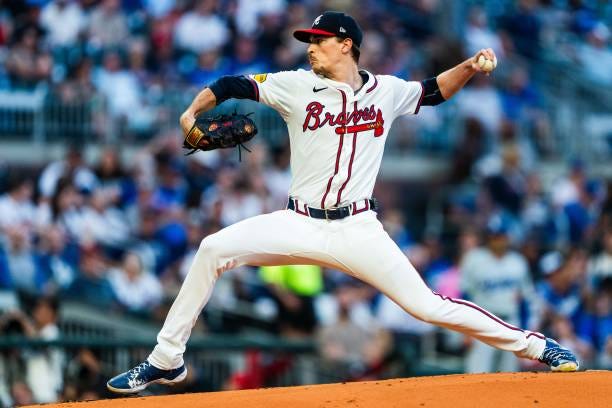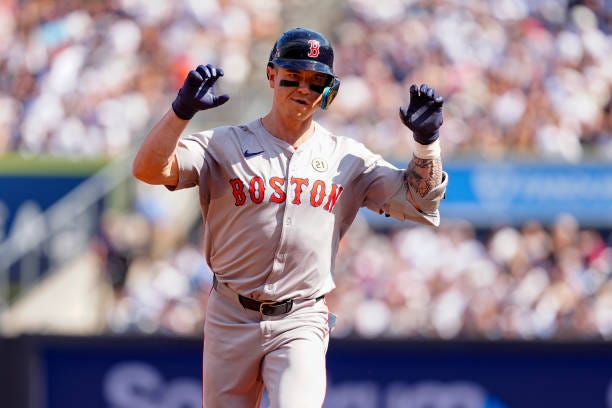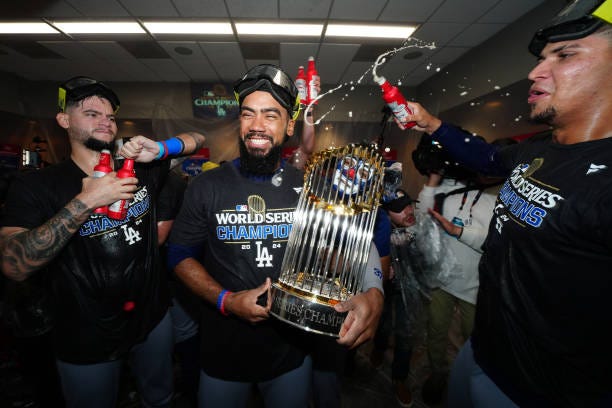Leandre: What does an A-plus Red Sox offseason look like?
Reasonably, Boston Red Sox fans have low expectations and lofty wishes entering the 2025 offseason. But what would perfection look like?
Following three consecutive years ending after 162 games, and five of the past six, the Boston Red Sox should come out swinging this offseason.
Whether they will or not remains a mystery, but after a less-than-entertaining American League playoff slate, it feels like a good offseason could catapult Boston from the outside looking in to viable World Series threat.
Defining priorities is Step 1, and Chief Baseball Officer Craig Breslow seems to have eyes like the rest of us; this team needs frontline starting pitching. Sure, right-hander Tanner Houck emerged as an All-Star, but assuming he maintains that kind of production feels too risky for what Boston’s aspirations should be.
Besides, the entire first half the omen of his elite production being unsustainable loomed, then the second half was entirely unchartered waters.
The team has Brayan Bello, who is hoping for a big league in (full) Year 3, Kutter Crawford, who is looking for more consistency, and Lucas Giolito, who hasn’t had a good year since 2022. Stability is paramount this winter.
But I’m preaching to the choir. The Red Sox have other needs as well, but what would the 100th percentile outcome look like?
1. Red Sox ink LHP Max Fried to a six-year deal worth $184 mil
Fried is the game’s lowest of keys great pitchers. Yeah, people know he’s great, but falling into the shadow of Spencer Strider and Chris Sale in recent years appears to have muddied his perception nationally.
I had him as a top 10 starter in the game entering 2024. While he’s probably fallen closer to the 15-17 range, he’s still as steady as they come.
The 2024 campaign was a “bad” one for him and he still finished with a 3.25 ERA over 29 starts, with a 2.82 in his final 27.
There’s no perfect signee this winter, so it’s worth mentioning that the southpaw became a lock to miss time. If you want to call a full season 32 starts, he missed four in 2021, two in 2022, 18 in 2023 and three in 2024. Obviously, 2023 is the outlier but it’s worth noting he has never been the pinnacle of a perfect bill of health.
So, why him over right-hander Corbin Burnes?
Simply put, Burnes wore down in the second half in 2024 and, while still great, is not nearly as dominant as he was when he won National League Cy Young in 2021. Moreover, Fried generates grounders at an elite rate while manipulating contact amongst the game’s best.
Down the line of importance is Boston adding a lefty, which they didn’t have in 2024 at all after trading the aforementioned Sale.
The Red Sox rotation after this signing would be as follows:
Max Fried LHP - $30.7 mil tax hit
Tanner Houck RHP - $3.8 mil*
Brayan Bello RHP - $9.2 mil
Lucas Giolito RHP - $19.2 mil
Kutter Crawford RHP - $3.9 mil*
*projected arbitration
Total: $66.8 mil
2. Add a lefty strikeout-getter and a righty GB specialist to bullpen
Addressing the latter first, I don’t mean a “pitch to contact” right-hander. When referring to a righty groundball specialist, I am not-so-subtly referring to New York Yankees free agent Clay Holmes, who is one of the game’s best despite not being viewed as such.
Since the midseason trade to the Bronx in 2021, Holmes posted a 2.69 ERA in 220 regular-season games (1.35 in the postseason). While I understand it can get ugly sometimes, is not literally every reliever susceptible to that?
Not making a direct comparison, but Guardians ace closer Emmanuel Clase led the league in blown saves in 2023 and will get serious consideration for Cy Young in 2024. Then, he completely blew up in October.
If Clase can get touched up sometimes, anybody can.
He will almost definitely seek a contract that pays him like a closer, and Boston should oblige in giving him one. Should he be the team’s closer? Probably not, because of who I am about to mention, but the Red Sox shouldn’t pull any punches in creating a dominant pitching staff this winter.
After all, the duo of Justin Slaten and Liam Hendriks — perceived as the two likeliest closers in 2025 — project to make $5.8 million against the tax. They can afford to commit in the ballpark of $11 to $13 million average annual value on Holmes for three years.
The lefty would be Tanner Scott. The organization reportedly is so nuts about him I’d almost be shocked if he didn’t end up in Boston.
The catch-22 is Edwin Diaz and Josh Hader make in the neighborhood of $20 million per year. Scott is well within his right to seek that kind of money. While philosophically I am not of the mindset that you should invest that kind of cash into the bullpen, getting Scott and Holmes for $30 to $33 million a year feels like a must.
Look at this bullpen should they land both guys:
Garrett Whitlock RHP - $4.7 mil tax hit
Luis Guerrero RHP - $800,000*
Greg Weissert RHP - $800,000*
Zach Penrod LHP - $800,000*
Clay Holmes RHP - $13 mil
Liam Hendriks RHP - $5 mil
Justin Slaten RHP - $800,000*
Tanner Scott LHP - $18 mil
*projected pre-arbitration
Total: $43.9 mil
While that’s 2.4x the salary of the 2024 World Series Champion Los Angeles Dodgers bullpen, the Dodgers have astronomically more invested in their rotation and lineup. Boston still has the luxury of being one of the game’s youngest lineups.
3. Sign a ‘Flyer Guy” to a one-year deal for starting pitcher depth
I know I just said Boston should be aggressive in its pursuit to create a great pitching staff.
However, I don’t want them to just blow past the luxury tax without paying attention to the margins. Hence, my desire to take a flyer on someone as depth.
As it stands, with Fried, Boston has a rotation as follows: Fried, Houck, Bello, Giolito, Crawford. As depth, they have prospect Hunter Dobbins, their deadline acquisition, Quinn Priester and Josh Winckowski. I want them to throw one more young first-round pick into the mix: Casey Mize.
Injuries kept Mize out most of 2022 and all of 2023, then another one sidelined him for two months this past summer. However, he was having a really solid campaign despite the lack of strikeouts before the hamstring injury.
He finished with a 4.49 ERA and 3.95 FIP in 102.1 innings pitched (1.3 fWAR).
This is about depth and nothing more. But having two former top prospects anchoring your Triple-A rotation would be massive for this organization in 2025.
4. Familiarity or upside: the Tyler O’Neill vs. Teoscar Hernandez debate
The A+ decision here is Hernandez, which would work as righting a wrong done by the organization last year when it wouldn’t go beyond a reported contract offer of two years worth $28 million total.
Hernandez all but admitted he wanted to go to Boston, raved about the fan base and the ballpark and the Red Sox didn’t love him back as much.
A year later, he hit 33 homers, drove in 99 runs and won a World Series with the Dodgers.
He’s going to be 32 and does carry some swing-and-miss with him, though considerably less than O’Neill.
However, O’Neill had an admirable first season despite the up-and-downness to it.
In 113 games, he hit 33 homers and drove in 61 runs while posting 2.5 fWAR. A lot was made of his inability to hit with runners in scoring position early in the year, but he rebounded with an .866 OPS and 123 wRC+ in such situations.
I don’t think there’s a wrong choice here for the 2025 season. The wrong choice is in the terms of the contract. O’Neill is 29, but oft-injured, while Hernandez is 32 and uber-durable. If they are getting identical deals, Boston needs to opt for Hernandez. However, if O’Neill is taking a three-year, $45 million deal and Hernandez is at three years, $75 million (hypothetically), it becomes a true debate.
Back to the wall, I think I’d opt for O’Neill if this wasn’t about an A-plus offseason, but it is — the A-plus is Hernandez.
Here’s what the lineup would look like:
Jarren Duran CF - $4.1 mil tax hit*
Rafael Devers 3B - $29.2 mil
Teoscar Hernandez LF - $25 mil
Triston Casas 1B - $800,000**
Masataka Yoshida DH - $18 mil
Connor Wong C - $800,000**
Wilyer Abreu RF - $800,000**
Trevor Story SS - $23.3 mil
Vaughn Grissom 2B - $800,000**
Total: $102.8 mil
Bench:
Rob Refsnyder OF - $2 mil
Ceddanne Rafaela UTIL - $6.3 mil
Veteran C - ~$5 mil
David Hamilton MIF - $800,000**
*projected arbitration
** projected pre-arbitration
Total: $14.1 mil
Batting total: $116.9 mil
Pitching total: $110.7 mil
Overall: $227.6 mil
Obviously, there are other expenses, like the rest of the 40-man roster, external acquisitions down the road, deferred money, etc. So the payroll will definitely exceed that rough estimate, but that MLB payroll is only $3 mil additional from the 2023 roster, which ended at $224.2 mil against the tax (12th in baseball).
That group of 26 can do some damage in the American League without blowing through the luxury tax so far that when expiring players like Hendriks and Giolito are off the books after the season, they feel too tempted to stand pat.
In my opinion, that addresses everything they need: Frontline starter, re-shaping the high leverage area of the bullpen and adding right-handed thump to the heart of the order, while also adding depth to the rotation (Dobbins and Mize).
Can the Red Sox lure away Teoscar Hernandez from the Dodgers in free agency this winter?
Dodgers slugger Teoscar Hernandez is one win away from punching his ticket into the World Series. Five days after the Fall Classic comes to an end, Hernandez will become a free agent; speculation will swirl on whether the Red Sox will be suitors for a second straight offseason.









Package Duran and Yoshida strait up for Crochet. No money